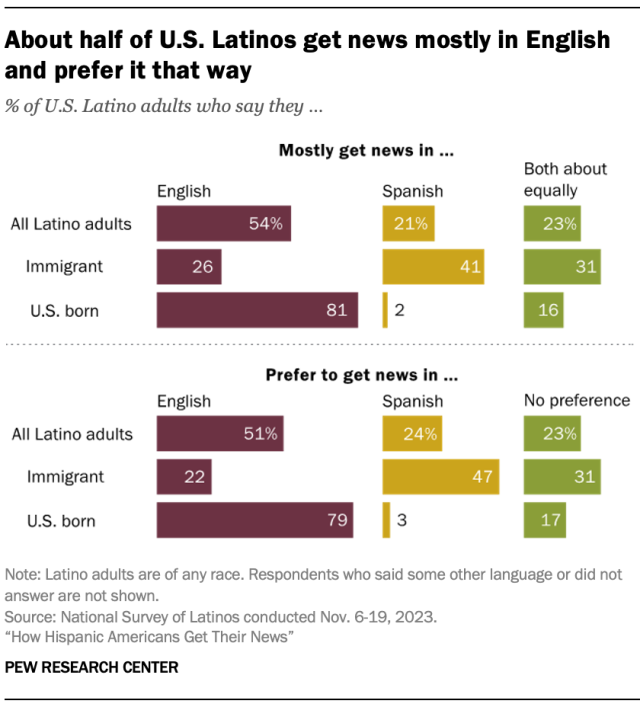☀️ Happy Thursday! The Briefing is your guide to the world of news and information. Sign up here!
In today’s email:
- Featured story: Jorge Ramos to leave Univision
- In other news: ABC’s fact-checking guardrails during the presidential debate
- Looking ahead: State attorneys general endorse federal plan to add warning labels to social media
- Chart of the week: About half of U.S. Latinos get news mostly in English and prefer it that way
🔥 Featured story
Jorge Ramos is leaving Univision after 40 years at the Spanish-language network. The TV anchor will depart at the end of 2024, after the U.S. presidential election. Ramos is among the leading voices of Hispanic journalism and has interviewed many presidents and other politicians in the U.S. and Latin America.
Half of U.S. Latinos say they at least sometimes get news from Hispanic news outlets – outlets that focus on providing news and information specifically to Hispanic audiences, whether in Spanish, English or another language. Latino immigrants are about twice as likely as Latinos who were born in the U.S. to get news from Hispanic outlets. These findings come from our recent study of Hispanic Americans’ habits around news and information.
Ahead of Hispanic Heritage Month, which begins in the United States each year on Sept. 15, explore our research on Hispanics and Latinos in America.
📌 In other news
- How ABC pursued real-time fact-checking during the Trump and Harris debate
- Trump Media stock prices drop after Trump and Harris debate
- A look at the role of social media during and after the presidential debate
- Los Angeles organizations and the American Journalism Project together raise $15 million for local news initiative
- Senate leaders urge FTC and Justice Department to investigate AI content summaries for antitrust violations
- Hedge fund seeks to end Murdochs’ control at News Corp
📅 Looking ahead
Amid ongoing concerns about the impact of social media on children’s mental health, jurisdictions are responding in multiple ways. More than 40 state attorneys general and U.S. Surgeon General Vivek Murthy are supporting a proposal to add warning labels to social media. And Australia has proposed banning social media for children under a certain age (between 14 and 16).
Parents of U.S. teens (ages 13-17) have a range of concerns about the effects of their teens’ social media use, according to a 2022 Pew Research Center survey. This includes 29% who say they are extremely or very worried it could lead to their child being harassed or bullied, and 28% who say the same about anxiety or depression.
When it comes to teens themselves, 23% say that what they see on social media makes them feel at least a little worse about their own life. But at the same time, teens are more likely to say social media has had a mostly positive (32%) rather than mostly negative (9%) effect on them personally, with 59% saying its effect has been neither positive nor negative.
📊 Chart of the week
With National Hispanic Heritage Month beginning on Sunday, this week’s chart focuses on the languages that Hispanic Americans get news in. According to a 2023 Center survey, just over half of U.S. Hispanic adults (54%) get their news mostly in English – far higher than the share who get their news mostly in Spanish (21%). An additional 23% say they get news in both languages about equally. Similarly, 51% of Hispanic Americans prefer to get their news in English, 24% prefer Spanish and 23% say they do not have a preference.
There are major differences in news consumption habits between U.S.-born Hispanic adults and those who immigrated from other countries. While U.S.-born Latinos overwhelmingly get their news in English, and prefer it in English, those born outside the United States have much more varied habits: 41% get their news mostly in Spanish, 26% get it primarily in English and 31% do both about equally.

👋 That’s all for this week.
The Briefing is compiled by Pew Research Center staff, including Naomi Forman-Katz, Jacob Liedke, Sarah Naseer, Christopher St. Aubin, Luxuan Wang and Emily Tomasik. It is edited by Katerina Eva Matsa, Michael Lipka and Mark Jurkowitz, and copy edited by David Kent.
Do you like this newsletter? Email us at journalism@pewresearch.org or fill out this two-question survey to tell us what you think.